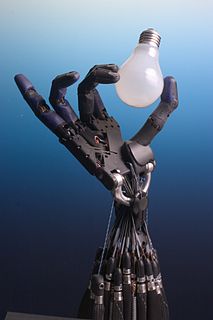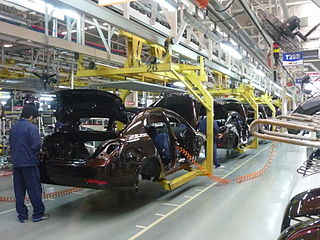
A robot is a machine—especially one programmable by a computer— capable of carrying out a complex series of actions automatically. Robots can be guided by an external control device or the control may be embedded within. Robots may be constructed on the lines of human form, but most robots are machines designed to perform a task with no regard to how they look.
The Document Style Semantics and Specification Language (DSSSL) is an international standard developed to provide a stylesheets for SGML documents.
Service robots assist human beings, typically by performing a job that is dirty, dull, distant, dangerous or repetitive, including household chores. They typically are autonomous and/or operated by a built-in control system, with manual override options. The term "service robot" does not have a strict technical definition. The International Organization for Standardization defines a “service robot” as a robot “that performs useful tasks for humans or equipment excluding industrial automation applications”.

In robotics a manipulator is a device used to manipulate materials without direct contact. The applications were originally for dealing with radioactive or biohazardous materials, using robotic arms, or they were used in inaccessible places. In more recent developments they have been used in diverse range of applications including welding automation, robotically-assisted surgery and in space. It is an arm-like mechanism that consists of a series of segments, usually sliding or jointed called cross-slides, which grasp and move objects with a number of degrees of freedom.
ISO 11784 & 11785 are international standards that regulate the radio frequency identification (RFID) of animals, which is usually accomplished by implanting, introducing or attaching a transponder containing a microchip to an animal.

An articulated robot is a robot with rotary joints. Articulated robots can range from simple two-jointed structures to systems with 10 or more interacting joints. They are powered by a variety of means, including electric motors.

A mobile robot is a robot that is capable of locomotion. Mobile robotics is usually considered to be a subfield of robotics and information engineering.
Industrial robots are highly repeatable but not accurate, therefore, robot accuracy can be improved through robot calibration. Robot calibration is the process of identifying certain parameters in the kinematic structure of an industrial robot, such as the relative position of robot links. Depending on the type of errors modeled, the calibration can be classified in three different ways. Level-1 calibration only models differences between actual and reported joint displacement values,. Level-2 calibration, also known as kinematic calibration, concerns the entire geometric robot calibration which includes angle offsets and joint lengths. Level-3 calibration, also called a non-kinematic calibration, models errors other than geometric defaults such as stiffness, joint compliance and friction. Often Level-1 and Level-2 calibration are sufficient for most practical needs.

Serial manipulators are the most common industrial robots and they are designed as a series of links connected by motor-actuated joints that extend from a base to an end-effector. Often they have an anthropomorphic arm structure described as having a "shoulder", an "elbow", and a "wrist".

A parallel manipulator is a mechanical system that uses several computer-controlled serial chains to support a single platform, or end-effector. Perhaps, the best known parallel manipulator is formed from six linear actuators that support a movable base for devices such as flight simulators. This device is called a Stewart platform or the Gough-Stewart platform in recognition of the engineers who first designed and used them.
Material handling equipment is mechanical equipment used for the movement, storage, control and protection of materials, goods and products throughout the process of manufacturing, distribution, consumption and disposal. The different types of handling equipment can be classified into four major categories: transport equipment, positioning equipment, unit load formation equipment, and storage equipment.

An agricultural robot is a robot deployed for agricultural purposes. The main area of application of robots in agriculture today is at the harvesting stage. Emerging applications of robots or drones in agriculture include weed control, cloud seeding, planting seeds, harvesting, environmental monitoring and soil analysis. According to Verified Market Research, the agricultural robots market is expected to reach $11.58 billion by 2025.

Robotics is the branch of technology that deals with the design, construction, operation, structural disposition, manufacture and application of robots. Robotics is related to the sciences of electronics, engineering, mechanics, and software.

Robotics is an interdisciplinary branch of engineering and science that includes mechanical engineering, electronic engineering, information engineering, computer science, and others. Robotics deals with the design, construction, operation, and use of robots, as well as computer systems for their control, sensory feedback, and information processing.
The following outline is provided as an overview of and topical guide to robotics:
Mobile manipulator is nowadays a widespread term to refer to robot systems built from a robotic manipulator arm mounted on a mobile platform. Such systems combine the advantages of mobile platforms and robotic manipulator arms and reduce their drawbacks. For instance, the mobile platform extends the workspace of the arm, whereas an arm offers several operational functionalities.

A cobot or co-robot is a robot intended to physically interact with humans in a shared workspace. This is in contrast with other robots, designed to operate autonomously or with limited guidance, which is what most industrial robots were up until the decade of the 2010s.
ISO 10218Robots and robotic devices — Safety requirements for industrial robots is an international standard for robot safety, developed by ISO/TC 184/SC 2 "Robots and robotic devices" in parallel with the European Committee for Standardization. It consists of two parts:
The Stanford arm is an industrial robot with six degrees of freedom, designed at Stanford University by Victor Scheinman in 1969. The Stanford arm is a serial manipulator whose kinematic chain consists of two revolute joints at the base, a prismatic joint, and a spherical joint. Because it includes several kinematic pairs, it is often used as an educational example in robot kinematics.












